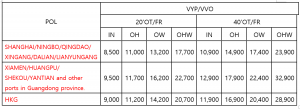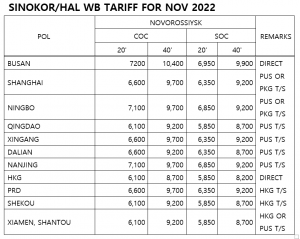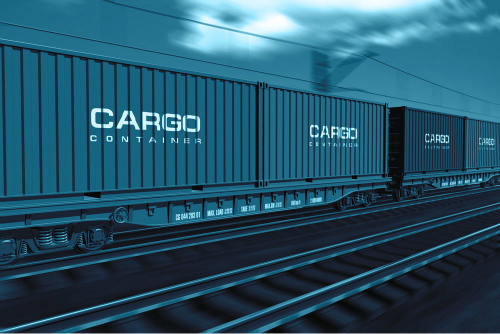USING TEU IS VERY CONVENIENT!
It’s interesting that 20 or 40 foot container became the standard only in 1964! Modern transportation cannot be imagined without containers for obvious reasons:
1.Container protects the cargo from environmental influences and ensures preservation for any mode of transportation;
2.The same container can be moved from one mode of transport to another (from ship to rail or truck) without unloading and reloading the contents of the container;
3.Container must be sealed, so only final consignee can open it. Sealed contained guarantees the safety of the cargo and helps to avoid a lot of claims against the carrier.
Hence, container transportation is very convenient, fast, reliable and affordable.
HOW TO CLASSIFY YOUR GOODS FOR EXPORT?
At first glance it seems simple matter. However, it might be difficult. The Commodity Code (HS CODE) is organized into 21 sections and 97 chapters, accompanied with general rules of interpretation and explanatory notes. In order to classify goods it’s necessary to know full description of the goods (size, specification, material composition and so on). Classifying your goods correctly will help to ensure that you pay the right duty for import-export and VAT and know whether import or export certification is required. Incorrect classification can lead to your goods being delayed or/and possible financial penalties.
O/F and Railroad Rates updated!
Dear Sirs, we here suggest the rates as below!
1) SITC
Service partially resumed from Shanghai. Stopped accept DG cargo
¾ Only can return container in VVO
¾ Free time 10 days
No drop off! No DG accepted.
SHANGHAI –VYP
COC FILO USD4100/USD6600
SOC FILO USD2900/USD4900
SHANGHAI –Sollers
COC FILO USD3800/USD6500
SOC FILO USD2600/USD3900
SHANGHAI –VVO
COC FILO USD3800/USD6500
SOC FILO USD2600/USD4300
2) HUA XIN
No DG accepted
BUSAN-Sollers
Rate is FIFO
USD2800/USD3800
POL TAICANG to Sollers
Rate is FIFO
FIFO USD2800/USD4800
TIANJIN -SOLLERS
Rate is FIFO
FIFO USD3400/USD5500
XIAMEN/QUANZHOU/SHANTOU-SOLLERS
Rate is FIFO
FIFO USD3200/USD5300
GUANGZHOU Sollers
Rate is FIFO
FIFO USD3300/USD5400
HAIKOU- SOLLERS
Rate is FIFO
FIFO USD3500/USD5700
NINGBO- SOLLERS
Rate is FIFO
FIFO USD3200/USD5200
NANJING/WUHAN- SOLLERS
Rate is FIFO
FIFO USD3100/USD5100
CHONGQING- SOLLERS
Rate is FIFO
FIFO USD3200/USD5200
POL QINGDAO to Sollers
Rate is FIFO
FIFO USD2900/USD4800
POL WENZHOU/FUQING to Sollers
Rate is FIFO
FIFO USD3300/USD5400
POL YINGKOU to Sollers
Rate is FIFO
FIFO USD3400/USD5500
 Drop off destination provide 30days for free
Drop off destination provide 30days for free
3) JUNNAN
No DG accepted.
All T/T around 7day directly vessel
But sometime will delay in POL as the weather is not good
POL TAICANG to VANINO /VYP( fix route)
COC FILO USD4450/USD6700
SOC FILO USD3550/USD5550
POL TIANJIN to VYP or fish port ,revert to actual schedule
COC FILO USD4450/USD6900
SOC FILO USD3550/USD5850
POL SHANGHAI/ VYP or fish port , revert to actual schedule
COC FILO USD4450/USD6700
SOC FILO USD3550/USD5550
POL NINGBO to VYP
COC FILO USD4450/USD6450
SOC FILO USD3550/USD5500
POL HUANGPU/SHENZHEN to VANINO/VYP
COC FILO USD4450/USD6800
SOC FILO USD3550/USD5800
POL QINGDAO to VYP
COC FILO USD4450/USD5900
SOC FILO USD3250/USD4800
POL SHANTOU to VYP
СOC FILO USD5050/USD7500
SOC FILO USD3550/USD5800
POL XIAMEN to VYP
COC FILO USD5050/USD7500
SOC FILO USD3550/USD5800
No drop off or have drop off = same price!!!
Only 20GP drop off Moscow
USD200 20GP drop off
SPB USD400 40HQ
drop off YekaterinburgUSD200
Drof off destinations: Moscow, Saint Petersburg, Irkutsk, Kazan, Krasnoyarsk, Blagoveschensk, Perm, Novosibirsk, Vanino, Tashkent, Minsk, Siktivkar, Bratsk, Kirov, Almaty, Samara, Chelyabinsk, Omsk, Tolligiatti, Malashevic, Chelyabinsk.
Remark!
1.All can drop off Moscow, Novosibirsk, no fee
2.IF cargo over 23T, will add USD400/container
3. COC container 60days free,over is 15USD/40HC/DAY
USD6 /20GP/DAY
4. cancel within 5day before ETD, cancel fee= total ocean freight
5. if postpone schedule after got space, Cancel fee USD 50/BILL
4) Zhonggu tariffs!
BIG delays, don't accept new bookings by now.
5) Neptune Carrier
Only 1th a month. Book carefully.
Now only one route POL NANSHA TO Vladivostokskiy Morskoy Port "Pervomayskiy" (VMPP)
T/T around 10days
Return container in VMPP
FILO USD4150/USD6400
Drop off in Moscow/Yekaterinburg/Novosibirsk/ St.Petersburg/Minsk
FILO USD3650/USD5900
Notice:
1.For Shipments to Final destinations: 60 days free usage after pick up ; 61-90th days: 15$/cntr/day; Cntr loss and damage fee will be charged by 5000$/40 in 90 days after pick up.
2.For Shipments to VMPP: 30 days free usage after pick up ; 31-60th days: 15$/cntr/day; Cntr loss and damage fee will be charged by 5000$/40 in 60days after pick up.
3.Free storage at VMPP for 5 days, 6-14th days: 75$/cntr/day;from 15th day: 150$/cntr/day
4.For shipments to VMPP: there is no limit for weight of cargo unit;
5.Above rates are valid for general cargo;rates are unvalid for Non ferrous metals
6) Sinokor Russian Far East
CARRIER : SINOKOR/HEUNG-A
BY COC
 REMARK
China- ZONE A : Shanghai/Ningbo/Qingdao/Xingang/Dalian/Nanjing/Xiamen/Shekou/Huangpu/Hong Kong
China – ZONE B : All other Chinese ports
Rate includes LSS/DTHC
SHANGHAI-VLADIVOSTOK COMMERCIAL : we have 2 options. DIRECT VESSEL OR T/S AT BUSAN
QINGDAO – VLADIVOSTOK COMMERCIAL : we have 2 options DIRECT VESSEL OR T/S AT BUSAN
Accepts DG cargo. By request + 1500 USD.
NO Li-ion batteries.
However, VGM weight cannot exceed 28t, so G/W must be controlled at about 25t.
Also, Vladivostok commercial port is very strict to check DG cargo in these days controlling total number of containers per voyage.
Hence, we recommend Vostochny as POD for the time being for quick dispatch.
Sinokor Drop off destinations: Moscow, Saint Petersburg, Ullianovsk, Ekateriburg, Novosibibrsk, Ufa, Irkutsk, Chelyabinsk, Omsk, Khababrovsk, Tolliagtti.
7) Sinokor > FR/OT .
Acceptable, but please check with me equipment availability before booking.
Following is our rate table for FR/OT.
REMARK
China- ZONE A : Shanghai/Ningbo/Qingdao/Xingang/Dalian/Nanjing/Xiamen/Shekou/Huangpu/Hong Kong
China – ZONE B : All other Chinese ports
Rate includes LSS/DTHC
SHANGHAI-VLADIVOSTOK COMMERCIAL : we have 2 options. DIRECT VESSEL OR T/S AT BUSAN
QINGDAO – VLADIVOSTOK COMMERCIAL : we have 2 options DIRECT VESSEL OR T/S AT BUSAN
Accepts DG cargo. By request + 1500 USD.
NO Li-ion batteries.
However, VGM weight cannot exceed 28t, so G/W must be controlled at about 25t.
Also, Vladivostok commercial port is very strict to check DG cargo in these days controlling total number of containers per voyage.
Hence, we recommend Vostochny as POD for the time being for quick dispatch.
Sinokor Drop off destinations: Moscow, Saint Petersburg, Ullianovsk, Ekateriburg, Novosibibrsk, Ufa, Irkutsk, Chelyabinsk, Omsk, Khababrovsk, Tolliagtti.
7) Sinokor > FR/OT .
Acceptable, but please check with me equipment availability before booking.
Following is our rate table for FR/OT.
 TERM : FI-LO
Rate includes LSS/DTHC
8) Sinokor rates to Novorossiysk.
TERM : FI-LO
Rate includes LSS/DTHC
8) Sinokor rates to Novorossiysk.
 Rate includes LSS/DTHC/Destination document fee
Accepts DG cargo. By request + 1000 USD.
NO Li-ion batteries.
However, VGM weight cannot exceed 28t, so G/W must be controlled at about 25t.
9) Other SNK and HAL POL by request is available
10) Railroad tariffs!
SHENZHEN/GUANGZHOU TO MOSCOW USD 9000/40HQ. ETD 30Nov
SHENZHEN/GUANGZHOU TO MINSK USD 10300/40HQ ETD 27NOV
ZHENGZHOU TO MOSCOW USD8000/40HQ ETD30NOV
SHANGHAI/NINGBO TO MOSCOW USD 9500/40HQ ETD 30NOV
QINGDAO TO MOSCOW USD 9200/40HQ ETD30NOV
XI’AN TO MOSCOW USD 8100/40HQ ETD 30NOV
Many other directions by inquiry.
NO 20feet.
Ex-works charges are around 300 USD
Please help to sign for our telegram chanel as well
t.me/uf_agent
Rate includes LSS/DTHC/Destination document fee
Accepts DG cargo. By request + 1000 USD.
NO Li-ion batteries.
However, VGM weight cannot exceed 28t, so G/W must be controlled at about 25t.
9) Other SNK and HAL POL by request is available
10) Railroad tariffs!
SHENZHEN/GUANGZHOU TO MOSCOW USD 9000/40HQ. ETD 30Nov
SHENZHEN/GUANGZHOU TO MINSK USD 10300/40HQ ETD 27NOV
ZHENGZHOU TO MOSCOW USD8000/40HQ ETD30NOV
SHANGHAI/NINGBO TO MOSCOW USD 9500/40HQ ETD 30NOV
QINGDAO TO MOSCOW USD 9200/40HQ ETD30NOV
XI’AN TO MOSCOW USD 8100/40HQ ETD 30NOV
Many other directions by inquiry.
NO 20feet.
Ex-works charges are around 300 USD
Please help to sign for our telegram chanel as well
t.me/uf_agent





